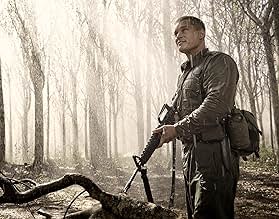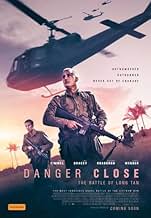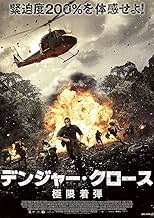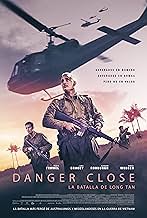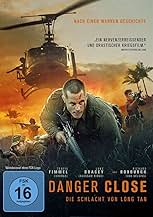NOTE IMDb
6,8/10
16 k
MA NOTE
En août 1966, dans une plantation de caoutchouc vietnamienne appelée Long Tan, 108 jeunes soldats australiens et néo-zélandais, se battent pour leur survie contre 2500 soldats nord-vietnamie... Tout lireEn août 1966, dans une plantation de caoutchouc vietnamienne appelée Long Tan, 108 jeunes soldats australiens et néo-zélandais, se battent pour leur survie contre 2500 soldats nord-vietnamiens et viet-cong.En août 1966, dans une plantation de caoutchouc vietnamienne appelée Long Tan, 108 jeunes soldats australiens et néo-zélandais, se battent pour leur survie contre 2500 soldats nord-vietnamiens et viet-cong.
- Récompenses
- 8 victoires et 6 nominations au total
Rihari Te Are
- Gunner Murry Watene
- (as Richard Te Are)
Histoire
Le saviez-vous
- AnecdotesThe term, "Roger that", is an Americanism, originally from CB radio culture, and often used in military movies. However, it would never be said (or permitted, by any NCO or Officer within earshot) in the Australian Army. "Roger" is the only accepted proword. Similarly, the phrase, "I repeat", when repeating some for clarity over the radio telephone (RATEL), is not permitted. Instead the operator would use, "I say again...". This is because "repeat" is a proword used when directing artillery or naval fire (e.g "request for the same volume of fire to be fired again with or without corrections or changes")
- GaffesThe entire battle took place in a torrential tropical downpour from start to finish. Evidently, this would be hard to film for dramatic purposes. The airstrike never happened not because of a dud smoke grenade, but the cloud was so low and rain so intense the pilots could not identity the target area.
- Citations
Major Harry Smith: There's a thousand ways to die in a war zone.
- Crédits fousPart way through the final credits, after showing the actors and pictures of their real life counterparts and some of the principal credits, acknowledgment of the 6RAR's Presidential Unit Citation from the USA made in 1968 but that Australia took 45 years to acknowledge the soldiers who fought in a similar way.
This is followed by an Honour Roll of the Australian Soldiers killed during this battle.
- ConnexionsFeatured in Danger Close: Behind the Scenes (2019)
Commentaire à la une
As movies about real battles go, this one holds its own.
If I have a criticism it would be what director Kriv Stenders himself was worried about when he showed the film to the real Harry Smith and veterans of the battle. Stenders was concerned "... that a cinematic interpretation of the film, overdramatizing some moments and fictionalizing others, would be an issue with veterans of the battle".
Although Harry Smith told Stenders he thought the film was great, I feel those scenes, especially the exchanges between Major Smith (Travis Fimmel) and Private Large (Daniel Webber), the stereotypical "Hollywood" stuff, do sound a false note. However, the film is a technical triumph with a superb score and, for the most part, seems honest to events.
The film is similar to Mel Gibson's "We Were Soldiers": the unexpected enemy force; the cut-off platoon; helicopter pilots defying orders to provide aid and impressive firepower that doesn't overshadow the discipline and guts of the troops on the ground. Both were straightforward battles without civilians caught in the crossfire.
As an Australian, I'm not sure how non-Australian audiences will view "Danger Close". The accents could be challenging and the look of the Australians and New Zealanders is noticeably different to the helmeted U.S. Army and Marines familiar from documentaries and newsreels. Ever since the war, the respective tactics of the allies have been dissected in books and back-and-forth sessions on military history blogs. The Diggers of that era actually looked like the U.S. Army LRRPs or even the VC; styled for jungle warfare.
Another thought, a great victory is only in proportion to the toughness of the enemy. All accounts I've read also acknowledge the bravery of the Vietnamese. You do see it in the film, but it could have been stated.
Despite the rights and wrongs of Australia's involvement, Long Tan has emerged as one of our most iconic battles. Maybe it's partly guilt over the way Vietnam veterans were neglected for so long. Maybe it's also because not much was expected of the "Baby Boomers", but they stood up nonetheless.
Like Peter Weir's "Gallipoli", "Danger Close" will probably be how future generations will know this battle. With that in mind, the filmmakers and the stars, despite the odd flaw, have left us with a powerful and affecting experience.
If I have a criticism it would be what director Kriv Stenders himself was worried about when he showed the film to the real Harry Smith and veterans of the battle. Stenders was concerned "... that a cinematic interpretation of the film, overdramatizing some moments and fictionalizing others, would be an issue with veterans of the battle".
Although Harry Smith told Stenders he thought the film was great, I feel those scenes, especially the exchanges between Major Smith (Travis Fimmel) and Private Large (Daniel Webber), the stereotypical "Hollywood" stuff, do sound a false note. However, the film is a technical triumph with a superb score and, for the most part, seems honest to events.
The film is similar to Mel Gibson's "We Were Soldiers": the unexpected enemy force; the cut-off platoon; helicopter pilots defying orders to provide aid and impressive firepower that doesn't overshadow the discipline and guts of the troops on the ground. Both were straightforward battles without civilians caught in the crossfire.
As an Australian, I'm not sure how non-Australian audiences will view "Danger Close". The accents could be challenging and the look of the Australians and New Zealanders is noticeably different to the helmeted U.S. Army and Marines familiar from documentaries and newsreels. Ever since the war, the respective tactics of the allies have been dissected in books and back-and-forth sessions on military history blogs. The Diggers of that era actually looked like the U.S. Army LRRPs or even the VC; styled for jungle warfare.
Another thought, a great victory is only in proportion to the toughness of the enemy. All accounts I've read also acknowledge the bravery of the Vietnamese. You do see it in the film, but it could have been stated.
Despite the rights and wrongs of Australia's involvement, Long Tan has emerged as one of our most iconic battles. Maybe it's partly guilt over the way Vietnam veterans were neglected for so long. Maybe it's also because not much was expected of the "Baby Boomers", but they stood up nonetheless.
Like Peter Weir's "Gallipoli", "Danger Close" will probably be how future generations will know this battle. With that in mind, the filmmakers and the stars, despite the odd flaw, have left us with a powerful and affecting experience.
Meilleurs choix
Connectez-vous pour évaluer et suivre la liste de favoris afin de recevoir des recommandations personnalisées
- How long is Danger Close?Alimenté par Alexa
Détails
Box-office
- Budget
- 24 000 000 $AU (estimé)
- Montant brut mondial
- 2 092 198 $US
- Durée1 heure 58 minutes
- Couleur
- Rapport de forme
- 2.35 : 1
Contribuer à cette page
Suggérer une modification ou ajouter du contenu manquant

Lacune principale
By what name was Danger Close: The Battle of Long Tan (2019) officially released in India in Hindi?
Répondre





